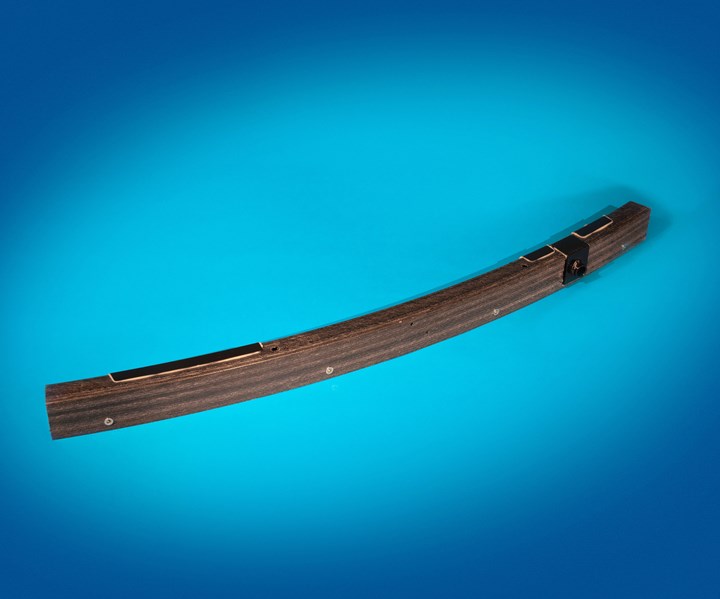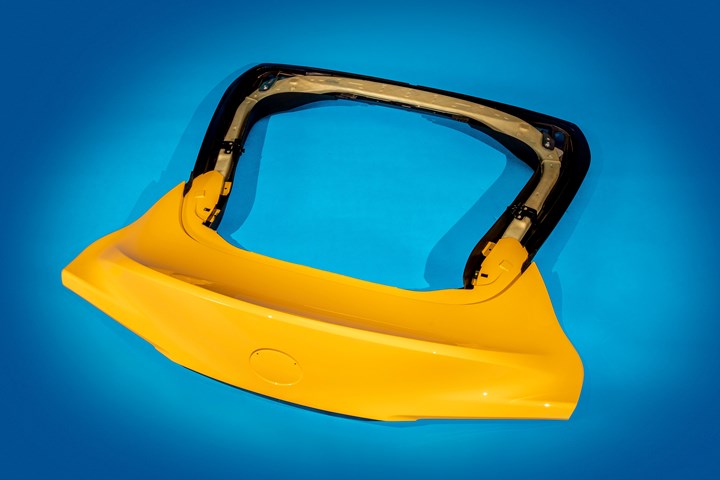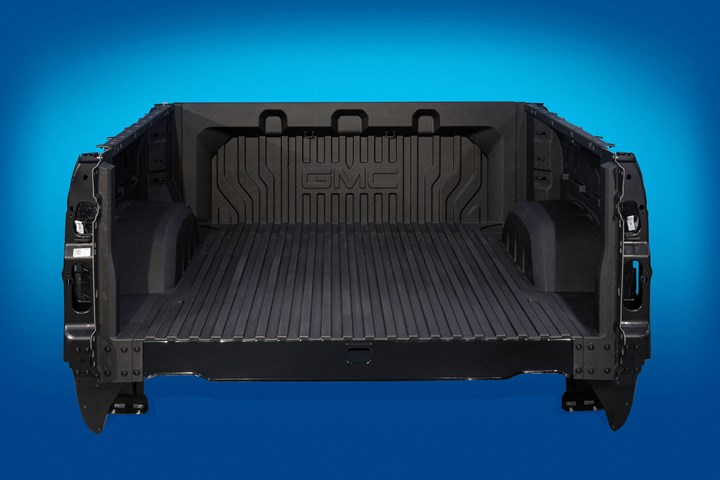Composites fare well at 2020 PACE Awards
This year’s automotive supplier award winners included composite bumper beam, liftgate and pickup box applications.
For 26 years, Automotive News magazine (AN, Detroit, Mich., U.S.) has presented its prestigious to honor commercial innovations in the global transportation supplier community. In the months leading up to the awards, a team of independent industry experts travels the world to visit each supplier submitting a nomination to hear in detail its benefits and see how it works. Then judges confer to pick competition finalists (30 made the cut this year) and winners, which normally are announced at a black-tie event in the Detroit area in April.
This year’s announcement was delayed as COVID-19 shut down not only the automotive industry, but most of the planet. However, on April 28, 2020, AN held a virtual awards ceremony via webinar and announced two Innovation Partnership and 13 Product / Process awards. Composites applications fared well in the competition, which this year was dominated by technology focused on vehicle lightweighting, advanced communications and enhanced visibility.
One PACE Innovation Partnership Award went to the team of General Motors Co. (GM, Detroit, Mich., U.S.) and tier one Shape Corp. (Grand Haven, Mich., U.S.) for their innovative work developing industry’s first curved pultruded automotive part — the rear bumper beam on the 2020 model year (MY) Chevrolet Corvette Stingray sports car (as featured in CW’s May 2020 issue). Weighing just 1.3 kilograms, the hollow, two-chambered carbon composite part contributes to vehicle stiffness and rear-crash performance, while its curved geometry better matches rear styling and fits in limited package space. Shape produces the beam via the radius pultrusion process and equipment (both developed by Thomas GmbH + Co. Technik + Innovation KG, Bremervörde, Germany) using both carbon fiber rovings and non-crimp fabrics with a polyurethane-acrylate matrix.

The auto industry’s first curved pultruded composite part — produced by Shape Corp. for the 2020 Chevrolet Corvette Stingray by General Motors Co.— was honored with an Automotive News 2020 PACE Innovation Partnership Award. The carbon composite rear bumper beam reduced mass 2.2 kilograms vs. the outgoing aluminum beam, was durable enough to travel with the body-in-white through the electrophoretic rust-coat process, and was produced via the radius pultrusion process, which is fast enough to meet high-volume automotive production requirements. Source, all images | SPE Automotive Div.
In the Process / Innovation category, two additional composite parts were winners. The first is the structural liftgate reinforcement produced by Magna Exteriors (Troy, Mich. U.S.) for the 2020 MY Toyota Supra sports car from Toyota Motor Corp. (Toyota City, Aichi, Japan). The lightweight, integral spaceframe replaced steel at 10% lower mass while boosting stiffness-to-weight ratios, lowering coefficient of linear thermal expansion (CLTE) and noise/vibration/harshness (NVH), improving dimensional stability, and lowering tooling costs. The filament wound structure — comprising fiberglass rovings wound around a reaction injection molded (RIM) polyurethane foam core, then impregnated with a polyurethane resin and formed via high-pressure resin transfer molding (HP-RTM) — also provides a continuous load path between hinges and latches. The technology is said to be ideal for meeting the needs of difficult packaging situations and challenging load cases.

The filament wound composite liftgate reinforcement structure developed by Magna Exteriors for Toyota Motor Corp. and first used on the 2020 Toyota Supra won a 2020 PACE Process / Innovation award. The fiberglass/polyurethane composite technology is said to fast enough to support higher production volumes and provides automakers with new styling features to create more complex and bolder shapes thanks to the ability to vary frame diameter, shape, and wall thickness.
The third composite part is the CarbonPro pickup box produced by Continental Structural Plastics, a Teijin Group co. (Auburn Hills, Mich., U.S.) for the GMC Sierra Denali 1500 and Sierra AT4 1500 pickups from GM (see the feature in CW’s June 2019 issue). As the industry’s first thermoplastic composite pickup box (compression molded from Sereebo chopped carbon fiber/polyamide supplied by Teijin Ltd., Tokyo, Japan), it reduced mass 40% (28 kilograms) and increased cargo carrying capacity (thanks to deep-draw molding capabilities) while offering significantly-higher impact performance than a steel box. The UV-stable material (with molded-in-color black) is corrosion and damage resistant, and eliminated the need for paint as well as an 18-kilogram bedliner, yet provides numerous customer features, including functional compartment dividers and motorcycle tire pockets.

Another 2020 PACE Process / Innovation award was given to industry’s first thermoplastic composite pickup box developed by General Motors Co., Teijin Ltd. and Continental Structural Plastics and debuting on the 2019 short-bed (crew cab) GMC Sierra Denali 1500 and Sierra AT4 1500 pickups. The thermoplastic material is fully recyclable at end of life. In fact, some molding scrap is reused to produce parts elsewhere on the vehicle.
Other 2020 PACE Product / Process award winners include:
- American Axle and Manufacturing Inc.: Electric driveline;
- Delphi Technologies: DiFlex integrated circuit;
- Ejot Fastening Systems: Ejoweld friction element welding;
- Gentex Corp.: Integrated toll module;
- Lear Corp.: Xevo commerce and service platform;
- Marelli: H-Digi lighting module;
- Mobileye: Road experience management system;
- Schaeffler Technologies: Compact transmission for e-axle application;
- Stoneridge Electronics: MirrorEye camera monitor system;
- Tenneco Powertrain Division: IROX 2 bearing coating; and
- Valeo: XtraVue trailer.
Additionally, Jaguar Land Rover and American Axle and Manufacturing won the second Innovation Partnership Award for joint development of an electric driveline.
This year’s awards were sponsored by Deloitte (London, U.K.), the Automotive Parts Manufacturers’ Association (Toronto, Ont., Canada), and Invest Canada (Ottawa, Ont., Canada).
Related Content
Partners recycle A350 composite production waste into adjustable-length rods for MFFD
Herone, Spiral RTC, Teijin Carbon Europe and Collins Aerospace Almere recycle A350 thermoplastic composite clips/cleats waste into rods for the all-thermoplastic composite Multifunctional Fuselage Demonstrator’s crown.
Read MoreMcLaren develops aerospace-inspired ART method for volume composite super car engineering
Automated rapid tape (ART) technique, already deployed at the MCTC and to be used for future McLaren models, is capable of producing lighter, stiffer and stronger carbon fiber structures with less waste.
Read MoreATA Industrial Group report evaluates the state of the global carbon fiber market
Carbon fiber composites market report provides statistics, analyses and trends regarding 2023 demand in China and around the world.
Read MoreSyensqo becomes new Solvay specialty materials company
Syensqo represents what was Solvay Composite Materials, focused on delivering disruptive material technologies and supporting growing customer needs.
Read MoreRead Next
Scaling up, optimizing the flax fiber composite camper
Greenlander’s Sherpa RV cab, which is largely constructed from flax fiber/bio-epoxy sandwich panels, nears commercial production readiness and next-generation scale-up.
Read MoreCeramic matrix composites: Faster, cheaper, higher temperature
New players proliferate, increasing CMC materials and manufacturing capacity, novel processes and automation to meet demand for higher part volumes and performance.
Read MoreCutting 100 pounds, certification time for the X-59 nose cone
Swift Engineering used HyperX software to remove 100 pounds from 38-foot graphite/epoxy cored nose cone for X-59 supersonic aircraft.
Read More.jpg;width=70;height=70;mode=crop)












